Strange Tales of Nobuo Nakagawa
- published
- 22 December 2005
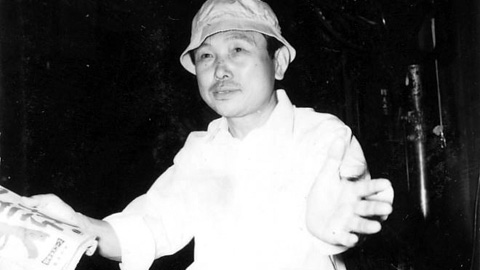
The years 2005 and 2006 saw filmmaker Nobuo Nakagawa (1905-1984) finally receive his long-overdue international breakthrough. In the fall of 2005, both the venerable Mostra in Venice and Paris's idiosyncratic Étrange Festival gave special nods to the man who is often referred to as Japan's master of the horror film. But it was once more Tokyo FILMeX that, after resuscitating Hiroshi Shimizu and Tomu Uchida in previous years, took the plunge and screened a special commemorative program of twelve of Nakagawa's films. (The retrospective went on to be shown in 2006 at the Berlin and Hong Kong film festivals.)
Both in and out of Japan, much of Nobuo Nakagawa's reputation rests on the atmospheric and very stylish horror films he churned out for the short-lived Shintoho studios in the late 1950s and early 1960s, most famously The Ghost Story of Yotsuya and his magnum opus Jigoku. These earned him the nickname 'the Terence Fisher of Japan', referring to the man who around the same period established the equally ambient and set-bound house style of Britain's home of horror, Hammer Studios. As the FILMeX retro proved, however, Nakagawa's talents went far beyond karmic tales of bloodsuckers and nightcrawlers. Here are eight of his lesser-known works, that demonstrate the enormous versatility of Nobuo Nakagawa.
Rivals
- Original title
- Enoken no Ganbari Senjutsu
- Cast
- Kenichi ENOMOTO, Mitsuko HIROKAWA, Takashi KOTAKA
- Year
- 1939
- Running time
- 63 mins.
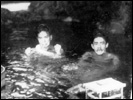 Early in his career, the genres Nobuo Nakagawa found himself most commonly working in were comedies and musicals. These were combined in the five films the director made in 1939/40 with the diminutive comic Kenichi Enomoto. (A belated sixth instalment followed, perhaps for old times' sake, in 1949.) 'Enoken', as he was affectionately known, wasn't much of a comedian: he couldn't sing very well, wasn't witty and had no great acting talent. But he managed to use all his inabilities, along with his peculiar physique, to his advantage, creating a buffoonish, somewhat masochistic public persona in films that revolved largely around self-mockery. Rivals sees Enoken involved in a ongoing feud with his neighbour and colleague. To the chagrin of their respective, long-suffering families, the two constantly try to humiliate and outdo each other, in the hopes of showing the other who's boss. Whether cycling to work, schmoozing up to the department head or taking lavish summer holidays, the pair will go to any length to top each other.
Early in his career, the genres Nobuo Nakagawa found himself most commonly working in were comedies and musicals. These were combined in the five films the director made in 1939/40 with the diminutive comic Kenichi Enomoto. (A belated sixth instalment followed, perhaps for old times' sake, in 1949.) 'Enoken', as he was affectionately known, wasn't much of a comedian: he couldn't sing very well, wasn't witty and had no great acting talent. But he managed to use all his inabilities, along with his peculiar physique, to his advantage, creating a buffoonish, somewhat masochistic public persona in films that revolved largely around self-mockery. Rivals sees Enoken involved in a ongoing feud with his neighbour and colleague. To the chagrin of their respective, long-suffering families, the two constantly try to humiliate and outdo each other, in the hopes of showing the other who's boss. Whether cycling to work, schmoozing up to the department head or taking lavish summer holidays, the pair will go to any length to top each other.
Enoken's lack of any genuine talent is clearly reflected in Rivals, which has none of the sophistication and inventiveness of the elaborate skits worked out by such American contemporaries as Buster Keaton or Laurel and Hardy. This is a populist kind of 'nonsense comedy', in which men acting like idiots, slapping each other upside the head, and pushing people into swimming pools are meant to provide most of the belly laughs. Enoken's impish charm and the frantic pacing of the gags save the day, though, which probably explains how he managed to make quite so many of these little movies. [TM]
Lynch
- Original title
- Shikei (Rinchi)
- Cast
- Kanjuro ARASHI, Eitaro SHINDO, Eijiro TONO, Ryo IKEBE, Yoshiko KUGA
- Year
- 1949
- Running time
- 98 mins.
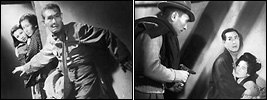 While directors like Anthony Mann and Carol Reed were creating brilliant film noir in the late 1940s, Nakagawa was doing it in Japan with Lynch, based on a short story by Sunao Otsubo and first released around Christmas of 1949.
While directors like Anthony Mann and Carol Reed were creating brilliant film noir in the late 1940s, Nakagawa was doing it in Japan with Lynch, based on a short story by Sunao Otsubo and first released around Christmas of 1949.
Spanning the pre and post-war period, the film tells the tale of Seikichi (Arashi), a working stiff in the Sugawara crime syndicate who's forced to steal a golden buddha statue from a temple. Instead of turning it over to his bosses, he stashes it and takes off with his lover Okayo, whom his nemesis Umewaka wants as chattel for himself. Gripped with the fear of getting caught, Seikichi turns himself in. He does hard time while Okayo and the Sugawara-gumi await his release on the outside. The film jumps years ahead and now focuses on his daughter Kuwako (Kuga, from films such as Kurosawa's The Idiot and Ozu's Good Morning), who's grown up into a tomboyish but beautiful singer fronting a traveling band. Her dream is to one day meet the father she believes has been a sailor at sea all these years. Sadly, Seikichi barely has time to take a breath on the outside as his ex-cohorts are waiting for him at the prison gates.
With its mixture of action, domestic drama, and yakuza intrigue, Lynch is a fairly memorable entry in Nakagawa's filmography. Hangdog-faced chanbara star Kanjuro Arashi (aka 'Arakan') was cast against type as a loser with his heart in the right place. His appearance and physicality before and after his long prison stretch are remarkable (thanks in part to convincing makeup). Yoshiko Kuga is lovely and lively as Arashi's daughter, who has a tough showbiz exterior but has never gotten over her daddy. The scene where she finally reunites with him just before he goes on the run one last time is genuinely moving. The symbolic use of wheels in Nakagawa's karmic universe is alive and well here. Arashi's character is a wheel-man himself, apparently quite rare during this period, and which informs the climactic chase sequence.
While the execution of Lynch doesn't quite live up to its concept, the performances are generally strong and afficionados of noir and crime cinema will appreciate what Nakagawa tried to achieve. [JG]
The Ceiling at Utsunomiya
- Original title
- Kaiki Utsunomiya Tsuritenjo
- Cast
- Ryuzaburo OGASAWARA, Akemi TSUKUSHI, Tetsuro TANBA, Sachiko TOYAMA, Yoichi NUMATA
- Year
- 1956
- Running time
- 80 mins.
 Around the perfunctory premise of a rich merchant wishing to marry a kind-hearted young woman against her and her boyfriend's will, a plot is spun of betrayal in the highest levels of the Tokugawa shogunate. The wandering ronin Ryutaro finds himself in the middle of the intrigue and chooses the girl's side, pitting himself against the merchant's minions, a band of loud-mouthed yakuza and a mysterious samurai who hides his face beneath a hood and wields his sword with only one hand - using the other to nervously twirl a pair of walnuts.
Around the perfunctory premise of a rich merchant wishing to marry a kind-hearted young woman against her and her boyfriend's will, a plot is spun of betrayal in the highest levels of the Tokugawa shogunate. The wandering ronin Ryutaro finds himself in the middle of the intrigue and chooses the girl's side, pitting himself against the merchant's minions, a band of loud-mouthed yakuza and a mysterious samurai who hides his face beneath a hood and wields his sword with only one hand - using the other to nervously twirl a pair of walnuts.
The actual machinations of the plot against shogun Iemitsu that lies at the heart of the proceedings remain unclear until the very end, though the film's title is a big clue. Nakagawa leaves the audience in the blind, drawing them into Ryutaro's investigation. He peppers the goings-on with ambivalent and off-beat characters and striking locations. Tanba's hooded, walnut-twirling samurai makes for a very peculiar villain and the actor succeeds in making the character's potentially silly nervous tic seem eerily sinister. (Though the film does contain one unintentionally funny moment when a samurai extra runs into the frame still wearing a very contemporary pair of glasses.) When the hood finally comes off, the film takes a sharp turn into horror territory that announces the shape of things to come for Nakagawa. [TM]
The Ghosts of Kasane Swamp
- Original title:
- Kaidan Kasanegafuchi
- Cast:
- Katsuko WAKASUGI, Takashi WADA, Noriko KITAZAWA, Tetsuro TANBA
- Year:
- 1957
- Running time:
- 66 mins.
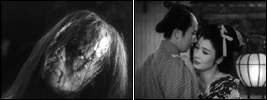 The vengeful ghost genre that Nakagawa so prolifically and successfully dabbled in is one that, like many of the stalwart genres of Japanese cinema, is heavily codified, to the point of being formulaic. Plots nearly always revolve around betrayal among couples, brought on by outside scheming and resulting in death, life-wrecking guilt and eventually revenge.
The vengeful ghost genre that Nakagawa so prolifically and successfully dabbled in is one that, like many of the stalwart genres of Japanese cinema, is heavily codified, to the point of being formulaic. Plots nearly always revolve around betrayal among couples, brought on by outside scheming and resulting in death, life-wrecking guilt and eventually revenge.
What Nobuo Nakagawa brought to the genre was a remarkable sympathy for his characters, whom he paints with careful touches instead of broad strokes. The Ghosts of Kasane Swamp is a case in point: its three protagonists in a doomed love triangle remain human throughout. They act from motivations that will find understanding and sympathy with any viewer, even when chasing each other around the house with knives drawn.
The film starts with the cold-blooded murder of an old, blind merchant by a drunken samurai. The swordsman hides the body in a nearby swamp, but is soon pestered by ghostly apparitions that eventually drive him mad, sending him wandering into the same swamp where he too finds his end. Jump forward twenty years, when the merchant's daughter Rui has grown into an elegant shamisen teacher (Wakasugi) and the samurai's son Shinkichi into a strapping if naïve young servant to O-Hisa, the beautiful daughter of the prosperous family on whose doorstep he was abandoned as an infant.
From there the plot kicks into gear, with the scheming merchant's son Seitaro who wishes to wed the eligible young lady, but recognising that she is in love with her servant. He hires the services of a creepy ronin, who himself has his eye set on Rui. When the samurai's machinations and social obligations force O-Hisa into wedlock with Seitaro, Shinkichi falls into the warm embrace of Rui, who needs a husband to keep the samurai at bay. Things complicate further and spiral down into an opera of jealousy, betrayal and vengeance from the beyond the grave, culminating in a riveting finale set which all the major players inevitably meet their fates at the titular cursed swamp.
Special mention must go to Katsuko Wakasugi, a breath-taking beauty who starred in a large number of the director's films of the late 1950s and who here makes an indelible impression as the one-eyed, vengeful woman, whose facial wound deteriorates into a grotesque bug-eyed mask at a supernatural pace. She would return to a similar sole in 1959's The Ghost of Yotsuya. [TM]
The Mansion of the Ghost Cat
- Original title
- Borei Kaibyo Yashiki
- a.k.a.
- Black Cat Mansion
- Cast
- Toshi HOSOKAWA, Yuriko EJIMA, Keinosuke WADA, Fujie SATSUKI, Shin SHIBATA, Ryuzaburo NAKAMURA, Noriko KITAZAWA
- Year
- 1958
- Running time
- 69 mins.
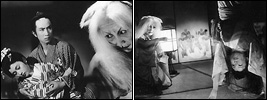 Nakagawa's occasionally striking entry in the bakeneko-mono (ghost-cat tale) horror subgenre. Dr. Kuzumi (Hosokawa) and his convalescent wife Yoriko (Ejima) return to her hometown in Kyushu in an effort to help her regain her constitution. They move into a broken-down, weed-infested, gated mansion. Almost immediately, Yoriko senses they're not alone, spotting a white-haired hag that disappears a breath later. Once the mansion is renovated into livable housing and a clinic, Yoriko is attacked by the same old woman, but her husband puts it down to "needing rest." Why is the withered witch determined to get her hands around Yoriko's young neck? The second act takes us back several hundred years for the answer. It's a tragic tale of a vicious lord (an impressive Shibata, also seen in The Ghost Story of Yotsuya) who takes the life of his young Go teacher and rapes his blind mother. In shame, she plunges a knife into her belly and entrusts her kitty kat with exacting revenge right down the lord's family line (servants included). Nakagawa makes the interesting and highly effective choice to film the present-day bookend scenes in black and white and the second act in gorgeous colour, including a surprising supply of sang and violent mayhem, considering the year the film was made.
Nakagawa's occasionally striking entry in the bakeneko-mono (ghost-cat tale) horror subgenre. Dr. Kuzumi (Hosokawa) and his convalescent wife Yoriko (Ejima) return to her hometown in Kyushu in an effort to help her regain her constitution. They move into a broken-down, weed-infested, gated mansion. Almost immediately, Yoriko senses they're not alone, spotting a white-haired hag that disappears a breath later. Once the mansion is renovated into livable housing and a clinic, Yoriko is attacked by the same old woman, but her husband puts it down to "needing rest." Why is the withered witch determined to get her hands around Yoriko's young neck? The second act takes us back several hundred years for the answer. It's a tragic tale of a vicious lord (an impressive Shibata, also seen in The Ghost Story of Yotsuya) who takes the life of his young Go teacher and rapes his blind mother. In shame, she plunges a knife into her belly and entrusts her kitty kat with exacting revenge right down the lord's family line (servants included). Nakagawa makes the interesting and highly effective choice to film the present-day bookend scenes in black and white and the second act in gorgeous colour, including a surprising supply of sang and violent mayhem, considering the year the film was made.
Mansion offers a fairly strong combination of horror and tragedy, only becoming unintentionally funny when the evil human-cat spirit pounces up (the feline makeup is impressive nonetheless). As Nakagawa's first anamorphic format film, the framing tends to be rather conventional (compared to Jigoku, for example), but long takes allow our eyes to soak up the rich colours of the past, the ink-black shadows of the present, and the amazing art direction throughout. Nakagawa had also begun to experiment, using slow-motion, on-set lighting changes, and looming superimpositions. This film cemented the partnership of Nakagawa and cinematographer Tadashi Nishimoto, which continued up until Nakagawa's masterpiece, The Ghost Story of Yotsuya (Nishimoto left Shintoho in the early 1960s and went to Hong Kong to shoot many films under the name Ho Lan-shan, such as Come Drink With Me, Hong Kong Nocture, and Way of the Dragon).
The Mansion of the Ghost Cat is certainly a precursor to Nakagawa's own later horror films and holds a karmic debt over what we know as "J-horror" today. [JG]
The Lady Vampire
- Original title
- Onna Kyuketsuki
- Cast
- Shigeru AMACHI, Keinosuke WADA, Torahiko NAKAMURA, Yoko MIHARA, Junko IKEUCHI
- Year
- 1959
- Running time
- 78 mins.
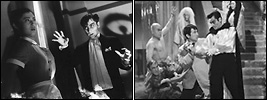 Nakagawa is credited with having made the first Japanese film to feature blood sucking with The Vampire Moth (Kyuketsuki-ga, 1956) for Toho. Almost exactly three years and fifteen films (!) later, and now with Shintoho (formed by producers and talent who left the former studio), Nakagawa's The Lady Vampire was Japan's first film with a Lugosi/Lee-like sartorial sang slurper in a lead role. Based on a novel by Soto Tachibana, whose work was also adapted by the director into The Mansion of the Ghost Cat.
Nakagawa is credited with having made the first Japanese film to feature blood sucking with The Vampire Moth (Kyuketsuki-ga, 1956) for Toho. Almost exactly three years and fifteen films (!) later, and now with Shintoho (formed by producers and talent who left the former studio), Nakagawa's The Lady Vampire was Japan's first film with a Lugosi/Lee-like sartorial sang slurper in a lead role. Based on a novel by Soto Tachibana, whose work was also adapted by the director into The Mansion of the Ghost Cat.
A woman named Miwako (Mihara) who's been missing for twenty years suddenly turns up alive, and looking not a day older than when she vanished. When her confused daughter Itsuko (Ikeuchi) sees a painting at an exhibition of a woman identical to her unaged mother, her cub reporter boyfriend Tamio (Wada) helps her track down the owner - an odd man named Nobutaka (Amachi). Actually a vampire named Shiro Sofue, he sees Miwako as his eternal, long lost lover. Soon after, he kidnaps and whisks her away to Shimabara in western Japan.
The climax leads Itsuko, Tamio, and the cops to the vampire's mountain-entombed castle, which is quite a set to behold, complete with all mod cons (even an acid bath). The vampire's motley crew of henchmen includes a bald brute with a musket rifle, a white-haired witch, and a scurrying dwarf. Nakagawa regular Amachi is amusing as the dandyish dracula, so different from his heavily burdened character in the later Jigoku. In a funny variation on the usual problem with sunlight, this vampire can be killed off by moonlight. During the final battle, the castle caves in, in one of several references to the "Amakusa Shiro" Christian uprising cited in the original novel (the others being the Shimabara location and of course the name "Shiro").
The crisp black and white cinematography and intentionally non-Japanese settings (the hotel, the castle, even the streets chosen) give the film a low-budget European feel. For whatever reason, there's much less experimentation than Nakagawa's other horror films. The Lady Vampire could really do with a lady vampire (the "lady" refers to Miwako's character, who does nothing but be in distress), which is probably why one of the export titles is The Vampire Man. Come to think of it, this vampire doesn't have much of a drinking problem at all. [JG]
Death Row Woman
- Original title
- Onna Shikeishu no Datsugoku
- Cast
- Miyuki TAKAKURA, Tatsuo TERASHIMA, Yoichi NUMATA, Keinosuke WADA
- Year
- 1960
- Running time
- 79 mins.
A Hitchcockian narrative and noirish atmosphere characterise this effective, taut little thriller, made the same year as the director's magnum opus Jigoku. Set in the present day, Death Row Woman is at once a prison film, an innocent-man/woman-on-the-run story, a police procedural and a family melodrama, equal parts Hitchcock, Sam Fuller, and Douglas Sirk.
Rich industrialist Imai wishes to marry his elder daughter Kyoko off to Aoki, whom he sees as the ideal candidate to take over his business. Kyoko, however, has different ideas and prefers the rugged but poor Soichi to Aoki's goody-two-shoes. Her stepsister Minako, however, already has her eye on Soichi, and becomes madly jealous when she spies the two in a passionate embrace during a family hunting trip.
That night, Kyoko decides to confront her father, obstinately refusing to marry Aoki and dropping the bombshell that she is pregnant with Soichi's child. She is banned from the family, but seconds after she leaves the room, the old Imai drops dead - poisoned, so the police discover, with cyanide in his whiskey. All evidence points toward Kyoko, who is sentenced to death despite her insistent claims that she is innocent. When she goes on the lam after a prison break with a cellmate, she realises that in order to prove her innocence, she has to team up with the fiancé she rejected.
The contemporary setting, though somewhat unusual for Nakagawa, makes the central role played by social mores in the director's work all the more apparent. Kyoko is sentenced more for stepping out of her role as a woman - she defies the sacrosanct patriarch figure and commits the sin of having a child out of wedlock - than for the actual evidence that points to her guilt. The ambiguity that characterises Nakagawa's best films, with characters revealing themselves as being far more rounded than they at first appear to be or need to be according to genre codes, is much in evidence here.
An excellent, admirably compact thriller (Nakagawa manages to cram an astonishing amount of story and characterisation into those 79 minutes), whose only flaw is the lack of charisma in lead actress Takakura. [TM]
Kaachan
- Original title
- 'Nendo no Omen' yori Kaachan
- Cast
- Yunosuke ITO, Yuko MOCHIZUKI, Terumi NIKI, Akihide TSUZAWA, Noriko KITAZAWA
- Year
- 1961
- Running time
- 88 mins.
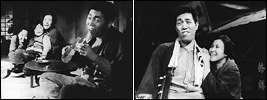 It goes without saying that post-WWII Tokyo was a tough time and place to survive, but just what was it like trying to scrape together an existence each day? Kaachan ("Mom" or "Mommy") visits one such struggling family in this almost neo-realist style film based on Masako Toyoda's novel.
It goes without saying that post-WWII Tokyo was a tough time and place to survive, but just what was it like trying to scrape together an existence each day? Kaachan ("Mom" or "Mommy") visits one such struggling family in this almost neo-realist style film based on Masako Toyoda's novel.
The year is 1949. Cantankerous but caring tinsmith-for-hire Yoshigoro (horse-faced Ito), his wife Oyuki (Mochizuki), and their young children Masako and Minoru live near the filthy Arakawa river in a shambolic neighbourhood of small home businesses - shoe and umbrella repairmen, rag makers and other denizens living a hand-to-mouth existence. It's New Year's Eve and all the poor family wants are some rice cakes to enjoy on the first day of what promises to be another hellish year. Due to Yoshigoro's massive pride and inability to hold down a regular job, they have epic arguments about money and constant worry about where their next meal is coming from, so Oyuki goes out on the sly and begs for loans, sometimes using Masako to elicit sympathy. Masako (excellent child actor Niki, who's still active today) is the shining light of the family - educated and kind, she likes to sing La Marseillaise (the French national anthem) and spend time with her teacher, Miss Kimura (Kitazawa, also in Nakagawa's Mansion of the Ghost Cat and The Ghost Story of Yotsuya).
Nakagawa really displays his talent for working with actors in this humanistic, warts-and-all portrayal of a family who subsist on hope. The widescreen black and white photography is worth noting, too. Much of the film takes place in the cramped hovels of the residents, broken up by exteriors that somehow find beauty in the misery and hardship - a potter's field funeral for a neighbour who succumbs to illness, Yoshigoro riding his bicycle out to work at dawn, and Masako running after her teacher's bus as she bids farewell. It wouldn't surprise me if Akira Kurosawa recalled Kaachan when shooting Dodes'kaden.
Kaachan was one of Nakagawa's final films for Shintoho, and one of master cinematographer Yoshimi Hirano's last, period. Watch for the amusing use of English dialogue in one scene. [JG]
Ghost Story of the Snake Woman
- Original title
- Kaidan Hebi Onna
- Cast
- Sachiko KUWAHARA, Akemi NEGISHI, Ko NISHIMURA, Shingo YAMASHIRO, Hideo MUROTA, Tetsuro TANBA
- Year
- 1968
- Running time
- 85 mins.
Nakagawa's post-Shintoho career was hardly a prolific one, with only six films between the studio's collapse in 1962 and the director's own passing in 1984. This 1968 Toei production is firmly in the genre that made his name, a story of revenge from beyond the grave by a family of poor farmers on the rich industrialist family that treated them like slaves and caused their deaths.
Unfortunately, despite being in familiar territory, Nakagawa fails to reach the level of his earlier films. Ghost Story of the Snake Woman lacks the ambiguity and subtleties of the Shintoho ghost films. The characterisation has much more in common with the resolute blacks and whites of the Toei studio's ninkyo eiga yakuza films (with which it shares the Meiji period setting and westernised baddies). The villians (played by studio stalwarts like Murota and Yamashiro) flaunt all the rules and behave like beasts, while the good guys endure and suffer because they are bound to obligations... until death liberates them from social restraints and paves the way for their revenge.
The film culminates in a stylish, madcap finale that is Nakagawa in top form, including a final shot that is a direct visual reference to Jigoku. Getting there, though, is a quite a trial indeed. [TM]